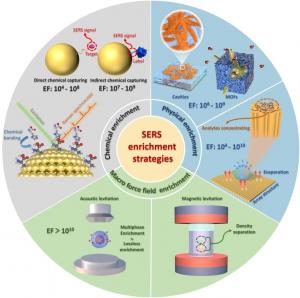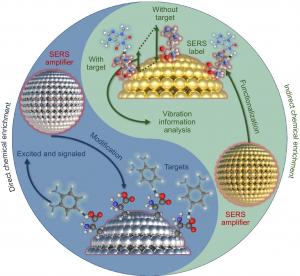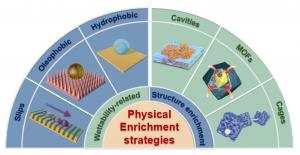Molecular ‘Escort’ Revolution - SERS Enrichment Technology Ushers in a New Era of Single-Molecule Detection
It highlights how this synergy achieves unprecedented sensitivity enhancements (104–1015 fold), unattainable through hotspot engineering alone.
CHENGDU, SICHUAN, CHINA, October 6, 2025 /EINPresswire.com/ -- Surface-Enhanced Raman Scattering (SERS) has become a cornerstone analytical technique in environmental monitoring, disease diagnosis, and public safety due to its single-molecule detection sensitivity. However, a fundamental limitation persists: over 70% of critical analytes (e.g., volatile organic compounds, heavy metal ions, pathogens) fail to effectively adsorb onto the hot spots of noble metal nanostructures. Molecules exhibiting surface inertness or size mismatch yield weak or undetectable signals. While extensive "hot spot engineering" optimizes substrate structures, more than 300 reviews published in the past five years confirm that substrate design alone cannot overcome the inherent limitation of insufficient molecule-hot spot coupling. Actively "escorting" trace molecules to sensing cores remains the key challenge to unlocking SERS’s practical potential.A team led by Prof. Chao Zhang from Shandong Normal University recently published a review titled " Enrichment Strategies in Surface-Enhanced Raman Scattering: Theoretical Insights and Optical Design for Enhanced Light-Matter Interaction " in Opto-Electronic Science. For the first time, the review systematically establishes a comprehensive SERS enrichment technology framework (Fig. 1).
After analyzing the core critical obstacle of "molecule-hot spot decoupling," the review positions enrichment strategies as the essential engine for surpassing detection limits, categorizing them into three systems:
1. Chemical Capture – Molecularly imprinted polymers and bio-aptamers construct an "intelligent recognition net" for precise single-molecule capture (Fig. 2): Chemical capture leverages specific chemical/biochemical interactions (e.g., covalent bonds, coordination chemistry, hydrogen bonding, ionic interactions, bioaffinity binding, molecular imprinting, host-guest chemistry) to selectively trap and concentrate target analytes onto SERS-active substrates. Applicable to diverse analytes, from small molecules, ions, and gases to proteins, nucleic acids, viruses, and whole bacterial cells, this method relies on functionalizing substrate surfaces with groups that specifically bind targets. It ensures reliable detection for molecules with stable chemical properties, weak adsorption affinity, or poor interaction with hot spots. Physical Confinement – Microcavity traps and superhydrophobic chips create "molecular cages," achieving over 10,000-fold concentration efficiency (Fig. 3).
2. Physical Confinement – Microcavity traps and superhydrophobic chips create "molecular cages," achieving over 10,000-fold concentration efficiency (Fig. 3): Physical confinement manipulates the diffusion of gas/liquid-phase analytes by designing SERS substrates with specific morphologies (e.g., microcavities, porous nanocages, superhydrophobic surfaces), forcing adsorption/enrichment at hot spots. This label-free strategy exploits geometric features (size, curvature, wettability) to create spatial barriers, minimizing interference with intrinsic molecular spectra. It shows unique advantages in complex liquid systems like environmental micropollutant monitoring.
3. Macroscopic Force Field Manipulation (Newly Proposed) - Acoustic/ magnetic/ optical levitation enables "non-destructive manipulation" for active capture of gas/liquid-phase molecules.
This innovative strategy applies external physical fields (acoustic/magnetic/optical) to separate and enrich targets via mechanical equilibrium principles, enabling nearly non-destructive SERS detection. It overcomes limitations of passive adsorption, avoids signal interference from substrate modification, and is ideal for analyzing labile samples like live bacteria and viruses.
In conclusion, the triple-enrichment system (chemical capture, physical confinement, force field manipulation) fundamentally addresses the "molecule-hot spot decoupling" limitation enabling sensitivity enhancements of 10⁴–10¹⁵-fold. However, translating this advancement to industrial applications requires overcoming critical challenges. These include achieving complete non-destructive recovery of trace molecules, resolving quantitative accuracy limitations caused by uneven hot spot intensities, and mitigating environmental interference from temperature, humidity, and pH fluctuations. To overcome these barriers, the review proposes integrated AI-driven next-generation solutions spanning intelligent substrate design, digital twin-based quantification, and autonomous detection systems, thereby paving the way for advanced SERS platforms with unprecedented analytical capabilities.
About the funding:
Supported by the National Natural Science Foundation of China (12174229, 12474408), Shandong Taishan Scholar Project (tsqn202306152), Shandong Provincial Youth Innovation Science and Technology Program (2021KJ006), and Shandong Provincial Natural Science Foundation (ZR2022YQ02).
About the Research team:
The "Laboratory of Optoelectronic Functional Materials and Devices" (Shandong Higher Education Key Laboratory) at Shandong Normal University’s School of Physics and Electronics. Led by Prof. Baoyuan Man, the team pioneers reversibly tunable SERS devices, macroscopic force field-based enrichment, and ML-assisted signal processing to address challenges in environmental sensing and biomolecule detection.
The team has published more than 300 papers in international journals, including Nature Communication, Advanced Functional Materials, Opto-Electronic Advance, Opto-Electronic science, ACS Photonics, Nano Energy, Nano Research, Phys. Rev. Members of the team have been awarded the first prize of Natural Science Award of Shandong Province, and have undertaken a number of national and provincial research projects, including the National Natural Science Foundation of China.
Read the full article here: www.oejournal.org/oes/article/doi/10.29026/oes.2025.250015
Andrew Smith
Charlesworth
+44 7753 374162
marketing@charlesworth-group.com
Visit us on social media:
LinkedIn
YouTube
Other
Legal Disclaimer:
EIN Presswire provides this news content "as is" without warranty of any kind. We do not accept any responsibility or liability for the accuracy, content, images, videos, licenses, completeness, legality, or reliability of the information contained in this article. If you have any complaints or copyright issues related to this article, kindly contact the author above.



